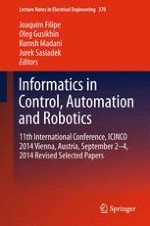The present book includes a set of selected extended papers from the 11th International Conference on Informatics in Control, Automation and Robotics (ICINCO 2014), held in Vienna, Austria, from 1 to 3 September 2014. The conference brought together researchers, engineers and practitioners interested in the application of informatics to Control, Automation and Robotics. Four simultaneous tracks will be held, covering Intelligent Control Systems, Optimization, Robotics, Automation, Signal Processing, Sensors, Systems Modelling and Control, and Industrial Engineering, Production and Management. Informatics applications are pervasive in many areas of Control, Automation and Robotics. ICINCO 2014 received 301 submissions, from 49 countries, in all continents. After a double blind paper review performed by the Program Committee, 20% were accepted as full papers and thus selected for oral presentation. Additional papers were accepted as short papers and posters. A further selection was made after the Conference, based also on the assessment of presentation quality and audience interest, so that this book includes the extended and revised versions of the very best papers of ICINCO 2014. Commitment to high quality standards is a major concern of ICINCO that will be maintained in the next editions, considering not only the stringent paper acceptance ratios but also the quality of the program committee, keynote lectures, participation level and logistics.
